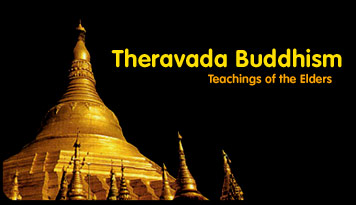|
| | Buddhism |  |
| | |
| Author | Message |
|---|
savyonok
Elder


Number of posts : 1841
Age : 49
Location : Sovyatnik
Registration date : 2006-04-06
 |  Subject: Buddhism Subject: Buddhism  Tue Apr 18, 2006 6:14 am Tue Apr 18, 2006 6:14 am | |
| Let us discuss this widely popular religion. | |
|   | | savyonok
Elder


Number of posts : 1841
Age : 49
Location : Sovyatnik
Registration date : 2006-04-06
 |  Subject: Re: Buddhism Subject: Re: Buddhism  Tue Apr 18, 2006 6:33 am Tue Apr 18, 2006 6:33 am | |
| The essence of Buddhism is usually put into its Four Noble Truths that comprise 1. the truth of suffering 2. the truth of the cause of suffering 3. the truth of the end of suffering 4. the truth of the path that leads to the end of suffering It emphasises on Renunciation, which is basically a recognition that all existence is suffering. This is why suffering is the first noble truth. Let share more of our thoughts upon its philosophy.    | |
|   | | Owlet
Guardian


Number of posts : 132113
Location : Sovyatnik
Registration date : 2006-04-06
 |  Subject: Buddhism Subject: Buddhism  Tue Apr 18, 2006 2:47 pm Tue Apr 18, 2006 2:47 pm | |
| Buddhism is a religion and philosophy based on the teachings of the Buddha, Siddhārtha Gautama, who lived in the 5th century BCE. Buddhism spread throughout the ancient Indian sub-continent in the five centuries following his death, and propagated into Central, Southeast, and East Asia over the next two millennia. Today, Buddhism is divided primarily into three traditions, Theravada, Mahayana, and Vajrayana. Buddhism continues to attract followers worldwide, and, with around 376 million followers, it is considered a major world religion. The Buddha is considered to be a person who discovered the true nature of reality through years of study, investigation of the various religious practices of his time, and meditation. This discovery is called enlightenment. According to the Buddha, any person can follow his example and become enlightened through the study of his words, and by leading a virtuous, moral life. In general, the aim of Buddhist practice is to end all kinds of suffering in life. To achieve this state, adherents seek to purify and train the mind by following the Noble Eightfold Path, and eventually to gain true knowledge of reality and thus attain liberation (Nirvana).  | |
|   | | Owlet
Guardian


Number of posts : 132113
Location : Sovyatnik
Registration date : 2006-04-06
 |  Subject: Gautama Buddha Subject: Gautama Buddha  Tue Apr 18, 2006 11:29 pm Tue Apr 18, 2006 11:29 pm | |
|  According to tradition, Siddhārtha Gautama was born in Lumbini. Lumbini is usually placed in what is now southern Nepal but alternate locations have been suggested in the state of Orissa in India. Siddhārtha's father was Suddhodana, a leader of the Shakya people. Traditions state that the Buddha's mother passed away at his birth or a few days later. The legend says that a seer predicted shortly after his birth that Siddhārtha would become either a great king or a great holy man; because of this, the king tried to make sure that Siddhartha never had any cause for dissatisfaction with his life, as that might drive him toward a spiritual path. Nevertheless, at the age of 29, he came across what has become known as the Four Passing Sights: an old crippled man, a sick man, a decaying corpse, and finally a wandering holy man. These four sights led him to the realization that birth, old age, sickness and death come to everyone. He decided to abandon his worldly life, leaving behind his privilege, rank, caste, and his wife and child, to take up the life of a wandering holy man in search of the answer to the problem of birth, old age, sickness, and death. Siddhārtha pursued the path of the yogi and meditated with two Brahmin hermits, and, although he quickly achieved high levels of meditative consciousness (dhyana), he was still not satisfied with the results. Gautama then began his training in the ascetic life and practicing vigorous techniques of physical and mental austerity. Gautama proved quite adept at these practices, and was able to surpass his teachers. However, he found no answer to his questions. Leaving behind established teachers, he and a small group of close companions set out to take their austerities even further. After six years of ascetism, and nearly starving himself to death to no profit, Siddhārtha began to reconsider his path. After discarding asceticism and concentrating on meditation, Gautama discovered what Buddhists call the Middle Way—a path of moderation away from the extremes of self-indulgence and self-mortification. Then, sitting under a pipal tree, now known as the Bodhi tree, he vowed never to arise until he had found the Truth. At the age of 35, he attained Enlightenment and became a Buddha. The enlightenment (Bodhi) of the Buddha Gautama was simultaneously his liberation from suffering and his insight into the nature of reality. The widely accepted doctrine of dependent origination states that any phenomenon ‘exists’ only because of the ‘existence’ of other phenomena in a complex web of cause and effect. For sentient beings, this amounts to a never-ending cycle of rebirth (samsara) according to the law of karma and vipaka. Because all things are thus conditioned and transient (anicca), they have no real, independent identity (anatta) and so do not truly ‘exist’, although to ordinary minds they do appear to exist. All phenomena are thus fundamentally insubstantial and empty (sunya). Wise human beings, who see things as they are (yatha-bhuta-ñana-dassana), renounce attachment and clinging which cause suffering (dukkha), transform the energy of desire into awareness and understanding, and eventually attain nirvana. For the remaining 45 years of his life, Gautama Buddha traveled in the Gangetic Plain of northeastern India, teaching his doctrine and discipline to all—from nobles to outcaste street sweepers, including adherents of many different schools and teachers. The Buddha founded the sanghas, the community of monks and that of nuns, which continued to declaim his teaching after his death. | |
|   | | Owlet
Guardian


Number of posts : 132113
Location : Sovyatnik
Registration date : 2006-04-06
 |  Subject: The first Buddhist Council Subject: The first Buddhist Council  Wed Apr 19, 2006 6:53 pm Wed Apr 19, 2006 6:53 pm | |
|  Soon after the passing of Gautama Buddha, the first Buddhist council was held. As with any ancient Indian tradition, transmission of teaching were done orally. Primary purpose of assembly were to collectively recite the teaching so to ensure that no errors occurs in oral transmission. In the first council, Ananda, the Buddha's personal attendant was called upon to recite the discourses of the Buddha (sutra/sutta), and Upali, another disciple, recited the monastic rules (vinaya). Buddhism still prolifilated slowly in India until Mauryan king Ashoka   began actively supporting it. His efforts at promotion led to the construction of Buddhist religious sites (stupa)  and to missionary efforts that spread the faith into neighboring lands. This period marks the first spread of Buddhism beyond India. According to the Edicts of Ashoka, emissaries were sent to various countries in order to spread Buddhism particularly in the neighboring Greco-Bactrian Kingdom, and possibly even farther to the Mediterranean. This led to the development of Greco-Buddhist art of Gandhara. It is also speculated that Buddhism incorporated influences "from popular Hindu devotional cults (bhakti) and Persian and Greco-Roman theologies which filtered into India from the northwest" (Lowenstein, 1996).
Last edited by on Fri Apr 21, 2006 1:15 pm; edited 1 time in total | |
|   | | savyonok
Elder


Number of posts : 1841
Age : 49
Location : Sovyatnik
Registration date : 2006-04-06
 |  Subject: Re: Buddhism Subject: Re: Buddhism  Wed Apr 19, 2006 9:55 pm Wed Apr 19, 2006 9:55 pm | |
| Owlet,
Please tell us about the differences between the three traditions, Theravada, Mahayana, and Vajrayana. | |
|   | | savyonok
Elder


Number of posts : 1841
Age : 49
Location : Sovyatnik
Registration date : 2006-04-06
 |  Subject: Re: Buddhism Subject: Re: Buddhism  Wed Apr 19, 2006 10:11 pm Wed Apr 19, 2006 10:11 pm | |
| The term Buddha means "Awakened". As he fully comprehended the Four Noble Truths and as he arose from the slumbers of ignorance he is called a Buddha.
Since he not only comprehends but also expounds the doctrine and enlightens others, He is called a Samma-Sambuddha --a Fully Enlightened One.
Before His Enlightenment he was a Bodhisattva which means one who is aspiring to attain Buddhahood. He was not born a Buddha, but became a Buddha by his own efforts. Every aspirant to Buddhahood passes through the bodhisattva period. | |
|   | | smetanka
Wiser


Number of posts : 424
Age : 46
Location : Russian 'saveshnik'
Registration date : 2006-04-06
 |  Subject: Re: Buddhism Subject: Re: Buddhism  Wed Apr 19, 2006 11:08 pm Wed Apr 19, 2006 11:08 pm | |
| Owlet, that's all so interesting!  And why the lotus is considered to be the symbol of Buddha? I saw the so-called tankas and almost in each Buddha is displayed with the lotus...Are there any other Buddhism symbols? | |
|   | | Owlet
Guardian


Number of posts : 132113
Location : Sovyatnik
Registration date : 2006-04-06
 | |   | | Owlet
Guardian


Number of posts : 132113
Location : Sovyatnik
Registration date : 2006-04-06
 |  Subject: Nikaya Buddhism Subject: Nikaya Buddhism  Thu Apr 20, 2006 1:35 pm Thu Apr 20, 2006 1:35 pm | |
| Nikaya Buddhism Nikaya Buddhism is a general term for those schools of Buddhism that accept only the class of sutras collected in the Pāli Canon as authentic. Historically, there were many Nikaya schools, but only one still exists today: the Theravada. Nikaya Buddhism is distinguished from the Buddhism of the various Mahayana and Vajrayana schools, which accept the authenticity of a range of other scriptures. However, the sutras of Pali Canon are accepted by every school, and outside Nikaya Buddhism they are known as the agamas or Nikayas. Many Western authors have used the term Hinayana to refer to Nikaya Buddhism. However, that term is now often seen as flawed on two levels. First, Hinayana, literally "inferior vehicle", is often regarded as an offensive or pejorative term and has never been used by Nikaya Buddhists to refer to themselves. Second, according to Mahayana and subsequent Vajrayana doctrine, "Hinayana" refers not to a sect or school of Buddhism but to a type of path to liberation which is contrasted with the path of the Bodhisattva. The term Shravakayana (literally, "the vehicle of hearers [i.e. disciples]") is sometimes substituted, but this meets only the first objection, and not the second. There were once at least eighteen Nikaya schools. According to tradition, the divisions within Nikaya Buddhism originated at the second Buddhist council, held about one hundred years after the Buddha's death. The subject of this council involved adherence to monastic rules (vinaya). Tradition states that the protagonists were two Nikaya Buddhist groups: a conservative group known as Sthaviravada which insisted on strict observation of vinaya and a more liberal group known as Mahasangikas which argued that some minor rules could be relaxed. The council ended with the rejection of the Mahasanghikas. A series of further disputes resulted in additional divisions. The now-defunct Nikaya schools are described under early Buddhist schools and branches of Buddhism.  | |
|   | | Owlet
Guardian


Number of posts : 132113
Location : Sovyatnik
Registration date : 2006-04-06
 |  Subject: Re: Buddhism Subject: Re: Buddhism  Thu Apr 20, 2006 1:57 pm Thu Apr 20, 2006 1:57 pm | |
|  During the reign of Emperor Asoka in India, the third Council was held in Pataliputra (250 BCE). The President of the Council, Moggaliputta Tissa, compiled a book called the Kathavatthu attempting to refute what he saw as the heretical, false views and theories held by some sects. The teaching approved and accepted by this Council was known as Theravada. Theravada (Pali; Sanskrit: Sthaviravada) is one of the eighteen (or twenty) Nikāya schools that formed early in the history of Buddhism. These developed in India during the century subsequent to the death of the Buddha. The name of the school means "Teachings of the Elders" which implies that this was the most conservative school of Buddhism, in the sense that it has attempted to conserve the original teachings of the Buddha. Adherents trace their lineage back to the Sthaviras (Pali: Theras; "Elders") of the First Buddhist Council when 500 arahants, including Mahakasyapa chose a position of orthodoxy to keep all the "lesser and minor" rules set by Gautama Buddha. Theravada is the longest surviving of the twenty schools, and for many centuries has been the predominant religion of Sri Lanka and continental Southeast Asia (parts of southwest China, Cambodia, Laos, Myanmar, and Thailand). It is also gaining popularity in Singapore and Australia. It is sometimes spuriously labeled as Hinayana ("Inferior Vehicle") in opposition to the Mahayana ("Greater Vehicle"), but this term is now widely seen as either inaccurate or derogatory. Theravada is sometimes referred to as Southern Buddhism. The oldest surviving use of the term Theravada in writing appears in the 7th century CE in that school's own manuscripts. In that document, according to Andre Bareau (Les sectes bouddhique du Petit Vehicule, p. 205), Theravada defines itself as a separate school, in distinction to the Mahasanghika, the Sarvastivada, and the Sammatiya. Today Theravada Buddhists number over 100 million worldwide, and in recent decades Theravada has begun to take root in the West.  | |
|   | | Owlet
Guardian


Number of posts : 132113
Location : Sovyatnik
Registration date : 2006-04-06
 |  Subject: Re: Buddhism Subject: Re: Buddhism  Thu Apr 20, 2006 2:11 pm Thu Apr 20, 2006 2:11 pm | |
|  Wat Phra Buddha Baat, a Theravada Buddhist temple in Thailand.  Shwedagon Pagoda in Yangon, Myanmar | |
|   | | Owlet
Guardian


Number of posts : 132113
Location : Sovyatnik
Registration date : 2006-04-06
 |  Subject: Theravada Subject: Theravada  Thu Apr 20, 2006 8:27 pm Thu Apr 20, 2006 8:27 pm | |
|  Theravada promote the concept of Vibhajjavada (Pali), literally "Teaching of Analysis" which uses critical methods of investigation as opposed to blind faith. With this method the answer has to be discovered by the aspirant, after being convinced by valid thought and experience, in order to reach the first glimpse of the goal. The Theravadins goal is the achievement of the state of Arahant (lit. "worthy one", "winner of Nibbana"), a life where all (future) birth is at an end, where the holy life is fully achieved, where all that has to be done has been done, and whereupon there is no more returning to the worldly life. In the Theravadin view, the attainment of arahatship is equal in every way to the realization attained by the Buddha himself. The Buddha remains a figure of reverence even for arahats because he was able to attain nibbana without the aid of any teacher or outside instruction—he is said to be 'fully self-enlightened' in many Pali verses of praise. Only after the development of the Mahayana did the insight or knowledge attained by an arhat come to be seen as a lesser form of that attained by the Buddha himself. In most Theravada countries, it is common practice for young men to ordain as monks for a fixed period of time. In Thailand and Myanmar, young men typically ordain for the 3 month Rain Retreat (vassa), though shorter or longer periods of ordination are not uncommon. Traditionally, temporary ordination was even more flexible among Laotians. Once they had undergone their initial ordination as young men, Laotian men were permitted to temporarily ordain again at any time, though married men were expected to seek their wife's permission. Throughout Southeast Asia, there is little stigma attached to leaving the monastic life. Monks regularly leave the robes after acquiring an education, or when compelled by family obligations or ill-health. Ordaining as a monk, even for a short period, is seen as having many virtues. In many Southeast Asian cultures, it is seen as a means for a young man to 'repay' his parents for their work and effort in raising him, because the merit from his ordination accrues to them as well. Thai men who have ordained as a monk may be seen as more fit husbands by Thai women, who refer to men who have served as monks with a colloquial term meaning 'cooked' to indicate that they are more mature and ready for marriage. Particularly in rural areas, temporary ordination of boys and young men traditionally gave peasant boys an opportunity to gain an education in temple schools without committing to a permanent monastic life.  Dhammakaya ordination Levels of AttainmentThrough practice, Theravadins practitioner can attain four degrees of spiritual attainment: Stream-Enterers - Those who have destroyed the three fetters (self-belief, doubt, and faith in the efficacy of rituals and observances), will be safe from falling into the states of misery (they will not be born as an animal, hungry ghost, or hell being). At most they will have to be reborn only seven more times before attaining Nibbana. Once-Returners - Those who have destroyed the three fetters (self-belief, doubt, and faith in the efficacy of rituals and observances), and the lessening of lust, hatred, and delusion. They will attain Nibbana after being born once more in the world. Non-Returners - Those who have destroyed the five lower fetters (that bind beings to the world of the senses), They will never again return to the human world. After they die they will be born in the deities worlds, there to attain Nibbana. Arahant - Those who have reached Enlightenment, awakened to the Nibbana and have reached the quality of deathlessness, free from all the fermentations of defilement; whose ignorance, craving, attachments, and karma have ended.  | |
|   | | Owlet
Guardian


Number of posts : 132113
Location : Sovyatnik
Registration date : 2006-04-06
 |  Subject: Re: Buddhism Subject: Re: Buddhism  Thu Apr 20, 2006 9:32 pm Thu Apr 20, 2006 9:32 pm | |
| | |
|   | | Owlet
Guardian


Number of posts : 132113
Location : Sovyatnik
Registration date : 2006-04-06
 |  Subject: Re: Buddhism Subject: Re: Buddhism  Thu Apr 20, 2006 10:42 pm Thu Apr 20, 2006 10:42 pm | |
| Dazzling Luang Prabang Temple, Laos Wat Phra Keo (Vientiane)  Vientiane: That Luang   | |
|   | | savyonok
Elder


Number of posts : 1841
Age : 49
Location : Sovyatnik
Registration date : 2006-04-06
 |  Subject: Re: Buddhism Subject: Re: Buddhism  Thu Apr 20, 2006 11:23 pm Thu Apr 20, 2006 11:23 pm | |
| The Wheel of Life - Take an interactive tour of the six worlds
http://www.buddhanet.net/wheel2.htm | |
|   | | MG_
Elder


Number of posts : 2724
Age : 40
Location : Almaty, KZ
Registration date : 2007-11-18
 |  Subject: Re: Buddhism Subject: Re: Buddhism  Sun Feb 03, 2008 1:33 am Sun Feb 03, 2008 1:33 am | |
| ok, and what about Lamaism? | |
|   | | Owlet
Guardian


Number of posts : 132113
Location : Sovyatnik
Registration date : 2006-04-06
 |  Subject: Re: Buddhism Subject: Re: Buddhism  Sun Feb 03, 2008 6:40 pm Sun Feb 03, 2008 6:40 pm | |
| The various schools of Buddhism have developed the different processes of attaining nibbana. Some teach a simple but rigorous following the Way; others teach enlightenment comes through regular and constant meditation (the various Ch'an and Zen methods are examples); or through an instantaneous awakening as the result of solving an apparently insoluble mental or verbal problem; and the koan, a Zen verbal puzzle. Tibetan Buddhism, also called LAMAISM, distinctive form of Buddhism that evolved from the 7th century AD in Tibet. It is based mainly on the rigorous intellectual disciplines of Madhyamika and Yogacara philosophy and utilizes the symbolic ritual practices of Vajrayana (Tantric Buddhism). Tibetan Buddhism also incorporates the monastic disciplines of early Theravada Buddhism and the shamanistic features of the indigenous Tibetan religion, Bon.  | |
|   | | Owlet
Guardian


Number of posts : 132113
Location : Sovyatnik
Registration date : 2006-04-06
 |  Subject: Re: Buddhism Subject: Re: Buddhism  Sun Feb 03, 2008 7:20 pm Sun Feb 03, 2008 7:20 pm | |
|  Lamaism - Buddhism of Tibet, Mongolia, and parts of Nepal and northern India; a form of Mahayana Buddhism. Buddhism was introduced into Tibet in AD 640, but the real founder of Tibetan Buddhism was the Indian missionary Padma Sambhava, who was active in about 750. Tibetan Buddhism developed several orders, based on lineages of teachings transmitted by reincarnated lamas (teachers). In the 14th–15th centuries Tsong-kha-pa founded the sect of Geluk-Pa (‘virtuous’), which became the most powerful order in the country. Its head is the Dalai Lama, who is considered an incarnation of the bodhisattva Avalokitesvara.  Lamaism represents the body of religious doctrine and institutions that were derived from Mahayana Buddhism, which was introduced in the 7th century. This Buddhism was married to both the Shamaistic Bon Religion and Tantric elements. The original Bon was a religion of magical and exorcist practices, which made the Lamaism dependent on the use of mantras, elaborate ritual, and the worship of guardian deities and living incarnations of Buddha. The double incarnation of the Bodhisattva is represented by the institutions of the Dalai-Lama (the political power) and the Tashi-Lama (the spiritual power). The two repositories of Lamaism are the Kan-jur with 108 books, and the Tan-jur containing 225 volumes. | |
|   | | Owlet
Guardian


Number of posts : 132113
Location : Sovyatnik
Registration date : 2006-04-06
 |  Subject: Re: Buddhism Subject: Re: Buddhism  Sun Feb 03, 2008 8:05 pm Sun Feb 03, 2008 8:05 pm | |
| Lhasa is the capital of Tibet, and the holy city of Lamaism.  | |
|   | | Owlet
Guardian


Number of posts : 132113
Location : Sovyatnik
Registration date : 2006-04-06
 |  Subject: Re: Buddhism Subject: Re: Buddhism  Sun Feb 03, 2008 8:20 pm Sun Feb 03, 2008 8:20 pm | |
| | |
|   | | Eule
Nestler


Number of posts : 666
Age : 41
Location : Germany
Registration date : 2006-05-20
 |  Subject: Re: Buddhism Subject: Re: Buddhism  Mon Jul 05, 2010 1:11 pm Mon Jul 05, 2010 1:11 pm | |
| The photos of Lhasa are interesting. And I also like the quote of the Dalai Lama. Here is another one I found during the last days: - Quote :
- I think it is very important to know we can each transform ourselves into a better, happier person. I think it’s important to recognize this. (Dalai Lama)
Actually, there is one quote of Buddha which is really important for me: - Quote :
- There is no way to happiness.
Happiness is the way. I try to practice this, but for me, it seems really complicated. For me, the content of this quote is the most important thing in my life I'm trying to ache for. Maybe someone here knows the quote? What does it mean to you? Cheers, Eule  | |
|   | | Owlet
Guardian


Number of posts : 132113
Location : Sovyatnik
Registration date : 2006-04-06
 |  Subject: Re: Buddhism Subject: Re: Buddhism  Mon Jul 05, 2010 2:08 pm Mon Jul 05, 2010 2:08 pm | |
| Eule, I had been practicing Theravada Buddhism meditation for many years, It had been very good for me.  | |
|   | | Eule
Nestler


Number of posts : 666
Age : 41
Location : Germany
Registration date : 2006-05-20
 |  Subject: Re: Buddhism Subject: Re: Buddhism  Mon Jul 05, 2010 2:19 pm Mon Jul 05, 2010 2:19 pm | |
| Hi Owlet,
what is Theravada Buddhism?
Actually, meditation is dangerous for me because of my disease/weak health situation.
Cheers,
Eule | |
|   | | Owlet
Guardian


Number of posts : 132113
Location : Sovyatnik
Registration date : 2006-04-06
 |  Subject: Re: Buddhism Subject: Re: Buddhism  Mon Jul 05, 2010 3:17 pm Mon Jul 05, 2010 3:17 pm | |
| - Eule wrote:
- what is Theravada Buddhism?
I was writing about that on the first page of this topik.  - Eule wrote:
- Actually, meditation is dangerous for me because of my disease/weak health situation.
This one is suppose to improve health issues, but I don't know about yours. It is called Vipassana. You can check it out here: http://www.german.dhamma.org/ | |
|   | | Sponsored content
 |  Subject: Re: Buddhism Subject: Re: Buddhism  | |
| |
|   | | | | Buddhism |  |
|
| | Permissions in this forum: | You cannot reply to topics in this forum
| |
| |
| |
